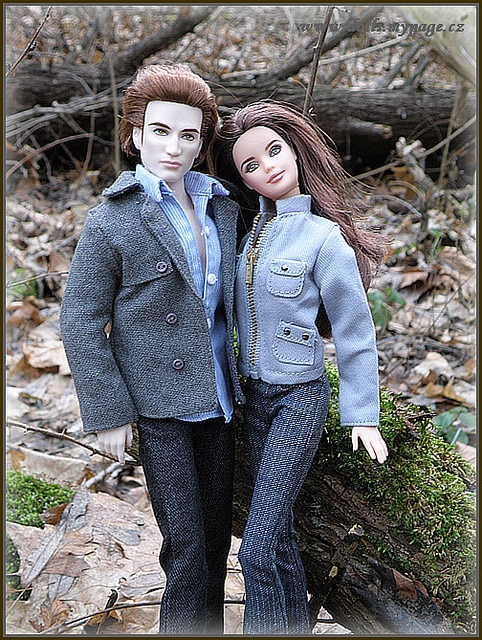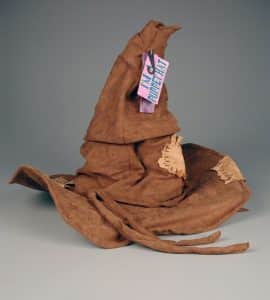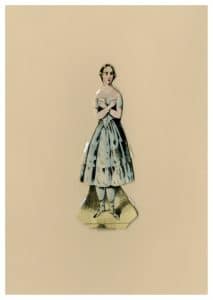 In 2009, Mattel introduced two new Barbie dolls, Edward and Bella, to their Pink Label collection. I’m sure most recognize this famous duo as Bella Swan and her sparkly vampire beau, Edward Cullen, from the Twilight saga. Mattel released the dolls in conjunction with the November 2009 premiere of the movie New Moon, and has since turned characters Jacob, Alice, Victoria, and Jane into dolls as well. It seems Mattel couldn’t help but notice that Twilight has a veritable army of dedicated followers, a.k.a. “Twihards,” who devour everything Bella and Edward (vampire pun intended). While I don’t count myself amongst the Twihards, I appreciate the pop culture phenomenon that Twilight has become, and view the resulting Barbie dolls as evidence of the blurred lines between popular culture—our favorite books, movies, and celebrities—and play.
In 2009, Mattel introduced two new Barbie dolls, Edward and Bella, to their Pink Label collection. I’m sure most recognize this famous duo as Bella Swan and her sparkly vampire beau, Edward Cullen, from the Twilight saga. Mattel released the dolls in conjunction with the November 2009 premiere of the movie New Moon, and has since turned characters Jacob, Alice, Victoria, and Jane into dolls as well. It seems Mattel couldn’t help but notice that Twilight has a veritable army of dedicated followers, a.k.a. “Twihards,” who devour everything Bella and Edward (vampire pun intended). While I don’t count myself amongst the Twihards, I appreciate the pop culture phenomenon that Twilight has become, and view the resulting Barbie dolls as evidence of the blurred lines between popular culture—our favorite books, movies, and celebrities—and play.
 Many other books and movies have infiltrated the realm of play. We dress up as our favorite characters for Halloween (and sometimes just for fun), take part in their adventures through video games, and collect related action figures and dolls. The Harry Potter series has prompted an empire of merchandise for aspiring wizards, including everything from board games to LEGO sets. Any true Star Wars fan has a legion of Luke Skywalker and Han Solo action figures. Countless other examples exist, and not all of them modern. In the 19th and early 20th centuries, before the development of movie theaters and television sets, Americans enjoyed other types of entertainment, some of which became very popular and inspired playthings of their own.
Many other books and movies have infiltrated the realm of play. We dress up as our favorite characters for Halloween (and sometimes just for fun), take part in their adventures through video games, and collect related action figures and dolls. The Harry Potter series has prompted an empire of merchandise for aspiring wizards, including everything from board games to LEGO sets. Any true Star Wars fan has a legion of Luke Skywalker and Han Solo action figures. Countless other examples exist, and not all of them modern. In the 19th and early 20th centuries, before the development of movie theaters and television sets, Americans enjoyed other types of entertainment, some of which became very popular and inspired playthings of their own.
 In 1850, Jenny Lind, a Swedish opera singer, embarked on an American tour arranged by none other than showman and impresario Phineas Taylor (P. T.) Barnum. Barnum’s skillful promotion of the “Swedish Nightingale” brought flocks of Americans to Lind’s 93 shows and in no time “Jenny Lind fever” ran rampant across the country (perhaps an affliction not unlike the feverish devotion Twihards exhibit). Lind’s name soon graced everything from bonnets to chewing tobacco and candlesticks, and she also appeared in paper doll form. Many other celebrities, such as Shirley Temple and Grace Kelly, would later follow in Lind’s footsteps and make their two-dimensional debut as paper dolls.
In 1850, Jenny Lind, a Swedish opera singer, embarked on an American tour arranged by none other than showman and impresario Phineas Taylor (P. T.) Barnum. Barnum’s skillful promotion of the “Swedish Nightingale” brought flocks of Americans to Lind’s 93 shows and in no time “Jenny Lind fever” ran rampant across the country (perhaps an affliction not unlike the feverish devotion Twihards exhibit). Lind’s name soon graced everything from bonnets to chewing tobacco and candlesticks, and she also appeared in paper doll form. Many other celebrities, such as Shirley Temple and Grace Kelly, would later follow in Lind’s footsteps and make their two-dimensional debut as paper dolls.
 The circus, Barnum’s primary claim to fame, became a favorite American pastime in the 19th century, and remained popular into the 1900s. Railroads made it possible for circuses to travel from town to town with ease, and in 1911 more than 30 circus companies toured the country. The circus craze that swept the nation prompted toy manufacturers, such as Philadelphia’s A. Schoenhut Company, to create miniature versions of the circus’ beloved performers and animals. Schoenhut apparently had a knack for producing toys based on popular culture, because in 1909, approximately a century before Mattel’s Twilight Barbies, Schoenhut introduced a new play set called Teddy’s Adventures in Africa. In the spring of that year, at the conclusion of his final term in office, President Theodore Roosevelt embarked on a yearlong African safari. Unlike the circus, Americans had to observe the safari from afar, but Roosevelt’s adventure received major media attention, securing for the Rough Rider a place not only in politics but in popular culture as well. The safari no doubt fueled the imaginations of countless children, and Schoenhut’s toys provided them with a way to play out their African adventures at home.
The circus, Barnum’s primary claim to fame, became a favorite American pastime in the 19th century, and remained popular into the 1900s. Railroads made it possible for circuses to travel from town to town with ease, and in 1911 more than 30 circus companies toured the country. The circus craze that swept the nation prompted toy manufacturers, such as Philadelphia’s A. Schoenhut Company, to create miniature versions of the circus’ beloved performers and animals. Schoenhut apparently had a knack for producing toys based on popular culture, because in 1909, approximately a century before Mattel’s Twilight Barbies, Schoenhut introduced a new play set called Teddy’s Adventures in Africa. In the spring of that year, at the conclusion of his final term in office, President Theodore Roosevelt embarked on a yearlong African safari. Unlike the circus, Americans had to observe the safari from afar, but Roosevelt’s adventure received major media attention, securing for the Rough Rider a place not only in politics but in popular culture as well. The safari no doubt fueled the imaginations of countless children, and Schoenhut’s toys provided them with a way to play out their African adventures at home.
Decades before Bella and Edward’s romance ever induced bouts of “Post-Twilight Depression” (it’s apparently a real thing, according to Urban Dictionary and countless sufferers), other forms of entertainment captivated American audiences, creating demand for playthings that immersed children in their favorite pastimes. But who knows, perhaps Edward Cullen, who became a vampire in 1918, attended a circus in his pre-undead youth, taking part in a craze long before he himself became one.
After all, Robert Pattinson, who portrays Edward in the Twilight movies, also stars in the Depression-era circus film Water for Elephants. Coincidence? Perhaps not.
 Hours 10 a.m.–5 p.m. | Fri. & Sat. till 8 p.m.
Hours 10 a.m.–5 p.m. | Fri. & Sat. till 8 p.m.